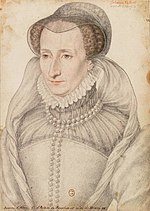| Battle of Orthez 1569 | |||||||
|---|---|---|---|---|---|---|---|
| Part of the French Wars of Religion | |||||||
| |||||||
| Belligerents | |||||||
| Huguenots | Kingdom of France | ||||||
| Commanders and leaders | |||||||
| Gabriel de Montgomery | Terride | ||||||
| Strength | |||||||
| c. 2,500 | |||||||
| French Wars of Religion | |
|---|---|
|
Second; 1567–1568 Third; 1568–1570 Fourth; 1572–1573 Fifth; 1574–1576 Sixth; 1577 Seventh; 1580 War of the Three Henrys (1585–1589) Succession of Henry IV of France (1589–1594) Franco-Spanish War (1595–1598) |
The battle of Orthez was fought during the French Wars of Religion, between August 11 and 14, 1569. Huguenot forces under the leadership of Gabriel de Montgomery defeated Royalist forces under Antoine de Lomagne, vicomte de Terride in French Navarre. Following the battle, Huguenot forces killed many of their Catholic prisoners.
Background
In the later half of the sixteenth century, all Aquitaine above the Garonne except for Bordeaux was in Protestant hands. At that time, Orthez was the largest and most dynamic city of Béarn. It was a market town which served as the main funnel for products making their way to Bayonne for export. Orthez was therefore quite wealthy. One wealthy Protestant, Adrien-Arnaud de Gachassin, had gifted his mansion in Orthez to Jeanne d' Albret in 1555 (today, it is called Maison of Jeanne d' Albret and has become a museum of how wealthy Protestants lived). The Huguenots were therefore desirous of capturing the important and wealthy town of Orthez.
Forces
The Huguenot army of Gabriel de Lorges, comte de Montgomery was a highly mobile force of 2,500, with a large proportion of cavalry.
En route to Orthez

The Protestant forces of Montgomery and Montamat had left Castres around noon on July 27, 1569. They pillaged along the way, passing through Mazères in Foix. The troops crossed the Garonne and the Gave at Coarreze and by August 9, they reached Queen Jeanne d' Albret’s castle at Navarrenx, which had been placed under siege two and a half months ago by the Catholic army of Antoine de Lomagne, vicomte de Terride. Terride, who had lifted the siege the previous day, withdrew his forces to Orthez.
On August 11, Montgomery crossed the Gave de Pau under fire and routed Terride's troops on the right bank. Isolated in Orthez and despairing of relief, Terride opened negotiations on August 14.
In the following days the Huguenots killed many of their prisoners. A special death was contrived for the clergy - they were thrown to their deaths from the heights of Orthez's Le Pont-Vieux over the Gave de Pau. In addition, the local Moncade castle was destroyed as well as the town’s churches and many homes.
Aftermath
Massacre of religious opponents characterised much of the Wars of Religion. Montgomery’s Huguenot troops committed subsequent massacres of Catholics in Artix, Tarbes, and elsewhere,

Based on correspondence and the memoirs of Jeanne III d'Albret, as well as the fact that the war was taken specifically to Orthez and Navarrenx by her direct orders, the historian Communay posits that she herself may have ordered the slaughter of the Catholic prisoners. Doubtless, however, the Huguenots were so enraged from the persecution inflicted on them by the Catholics that they could not be restrained from the massacre.
Montgomery's victory at Orthez gave the Huguenots the ability to recover after, in October, their main field army was destroyed at Moncontour.
References
- Dupuy, Richard Ernest; Dupuy, Trevor Nevitt (1993). The Harper Encyclopedia of Military History: From 3500 BC to the Present. HarperCollins. p. 522. ISBN 978-0-06-270056-8.
- Bryson, David (1999). Queen Jeanne and the Promised Land: Dynasty, Homeland, Religion and Violence in Sixteenth Century France. Leiden, Boston, Köln: Brill. p. 230.
- Landurant, Alain (1988). Montgomery le régicide. Paris: Tallandier. p. 185.
- Marlet, Léon (1890). Le Comte de Montgomery. Paris: Picard, Libraire-Éditeur. pp. 89–90.